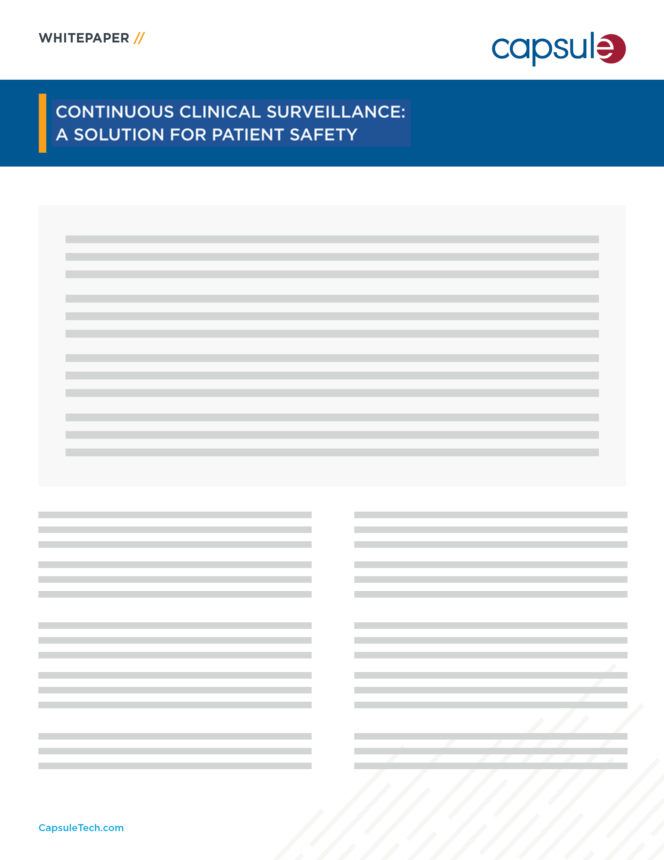Making the Complex Simple
With a wider variety of inbound data sources comes the need for greater data governance, but, more importantly in healthcare, information governance. The American Health Information Management Association (AHIMA) defines information governance as “an organization-wide framework for managing information throughout its lifecycle and supporting the organization’s strategy, operations, regulatory, legal, risk, and environmental requirements.”[1] The distinction between data and information is the context. For example, a simple oxygen saturation measurement at 97% is a single data point. But this data point gains clinical importance with context, such as Jane Doe’s SpO2 was 97% at 5:30pm.
How does the healthcare organization analyze and report on data to provide meaningful information to the care team?
The functionality of the Reporting and Analytics software enables transforming data into information. During the normal course of treatment clinicians must survey findings to evaluate the patient’s current state relative to treatment, taking into account their patient’s personal demographics to ensure that the right treatment is administered at the right time. Built on a SQL server framework, the Reporting and Analytics application software provides a metadata component with centralized access to the real-time medical device data along with raw vital signs, and Admission Discharge Transfer (ADT) information. This allows users to quickly join and perform mathematical operations on the dataset, accounting for demographics, past and present time annunciations of alarms, average values of vitals or even cumulative quantities of occlusions or desaturation events.
RELATED READING: Making the Complex Simple with a Data Analytics Solution for Investigating Real-time Medical Device Data (Part 1 of 2)
A Tool for Serious Medical Device Data Analysis
The expanded use of cloud computing has enabled improved delivery of information technology (IT) services within healthcare organizations enhancing scalability, accessibility, and storage of data. Data-as-a-service (DaaS), one of the many cloud computing models, provides increased availability of essential data to users on demand through centralized hosting and integration of data sources.[2] Furthermore, the DaaS strategy facilitates increased automation through the application of artificial intelligence (AI). Virtual intensive care units (vICU), highly utilized throughout the COVID-19 pandemic, benefit from the DaaS model bringing vital physiological data to bunkers for clinicians to analyze and deliver tele-critical care.[3]
How does the healthcare organization gain greater accessibility to their data?
The vast quantities of medical device data previously underutilized due to the lack of direct collection can now be queried, retrieved, and analyzed through various functions of the Reporting and Analytics application software. The Reporting & Analytics Author Report, Author Analysis and Dashboard capabilities enable users to simultaneously view different representations of real-time medical device alarms and raw trend data all in one location. For example, a respiratory therapist can review in tabular form the top mechanical ventilator alarm annunciations by room, alongside a scatterplot indicating the variation in vital signs associated with a particular patient experiencing many alarms. All raw data can be exported in common formats, such as Comma Separated Value (CSV), MS Excel, or PDF file formats for further offline analysis.
Clinical Informatics is Here to Help
Capsule’s Clinical Informatics Group (CIG) aids healthcare organizations in utilizing their medical device data to create more clinically actionable information in the form of notifications known as Smart Alerts. The Capsule Clinical Surveillance software allows for deployment and utilization of these Smart Alerts. The CIG develops custom analytics reports and assists the healthcare organization to better understand their patient’s real-time data. The group further supports the care team through training and self-paced videos.
Reporting and Analytics: Building the Better Data Mousetrap
Reporting and Analytics allows healthcare organizations to track patterns in alarms and vital signs. Furthermore, clinicians can dive into deeper analysis of patients to monitor changes in condition and personalize their treatment plans. Data captured using the Reporting & Analytics suite of software applications facilitates the continuing accumulation of medical device data from patients located throughout the healthcare system. This developing body of evidence can, in turn, lead to better predictions and outcomes for patients by arming the clinical staff with proactive information easily accessed. Reporting and Analytics makes the complex data lake of medical device data more accessible using straightforward methods, and these methods make for simplicity in use and provide better insight for improved patient safety and care management.
About the author
Jessica Serrao is a clinical informatics data scientist and John Zaleski, Ph.D., NREMT, CAP, CPHIMS is head of clinical informatics at Capsule Technologies.
Read more about clinical surveillance in critical care to learn how Smart Alerts can be utilized.
Download